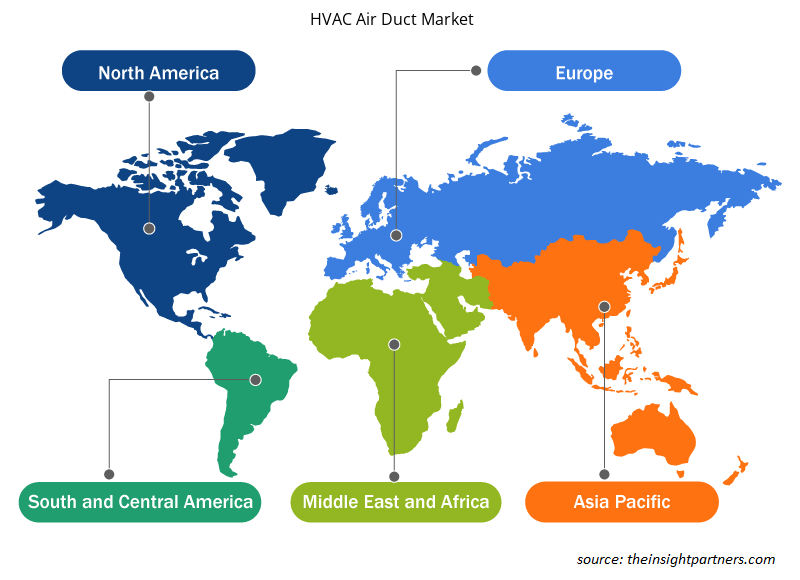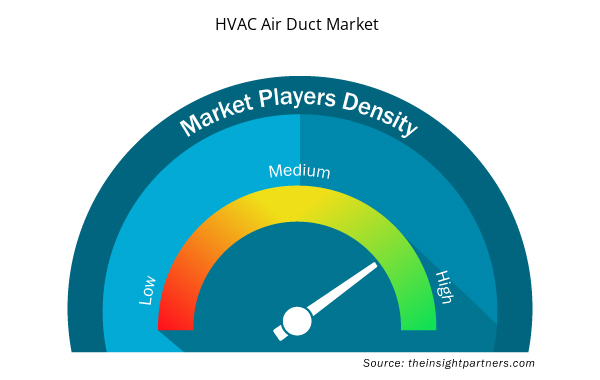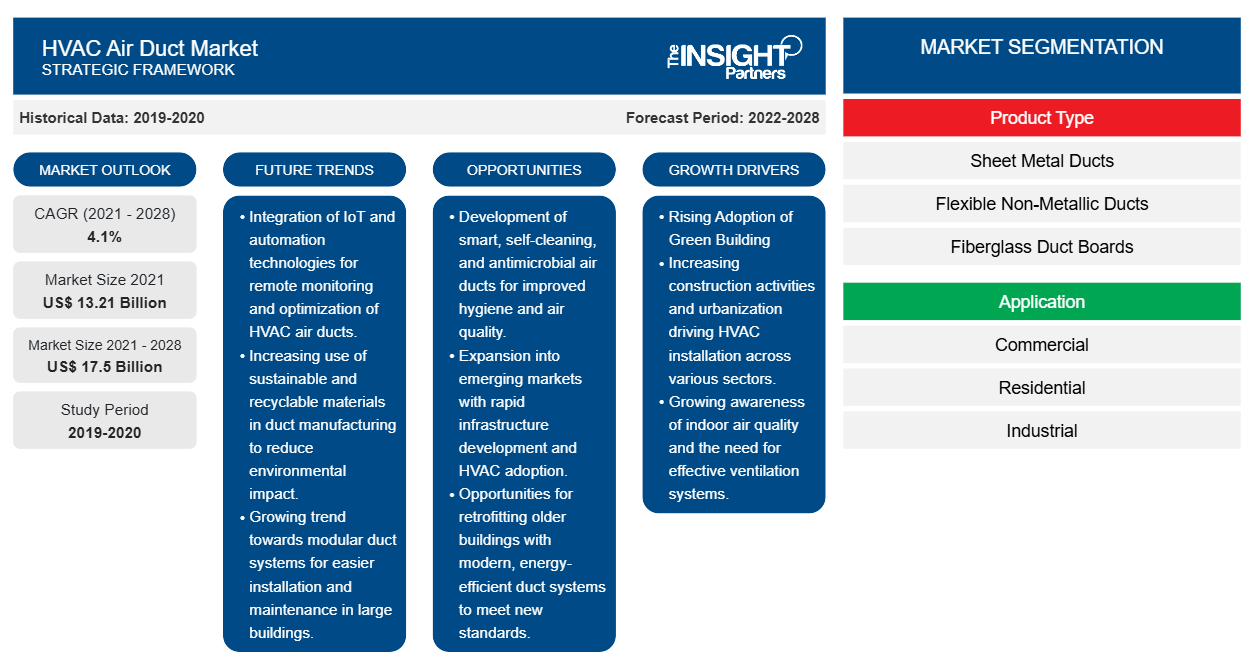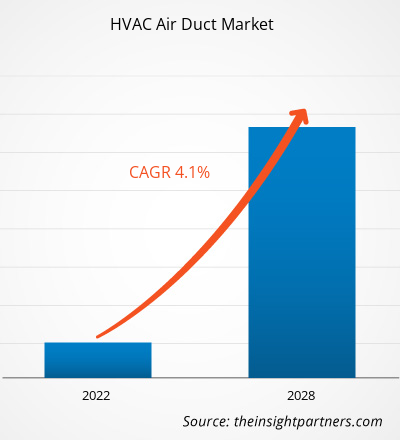2021 年 HVAC 风管市场价值为 132.137 亿美元,预计到 2028 年将达到 175.026 亿美元;预计 2021 年至 2028 年的复合年增长率为 4.1%。
对绿色建筑技术的日益关注和数据中心数量的增加推动了暖通空调风管市场的增长。绿色建筑提供了许多经济或财务效益,这些效益与一系列不同的人或人群有关。随着美国、加拿大、德国、英国、中国等国家越来越多地采用绿色建筑,对先进暖通空调系统的需求也在激增。许多住宅和商业部门的建筑师和政府都实施绿色建筑技术,因为它具有各种好处,例如更高的能源效率、更低的碳足迹和对环境的影响更小。这一因素催化了对暖通空调系统的需求,从而推动了暖通空调风管市场的增长。此外,全球数据中心数量的不断增长推动了对暖通空调系统的需求,从而推动了暖通空调风管市场的增长。此外,地热热泵 (GHP) 在住宅和商业建筑中的应用日益广泛,为暖通空调风管制造商提供了有利可图的机会。该技术广泛用于场所供暖和制冷,其广泛接受预计将在未来几年增加对 HVAC 风管的需求。
定制此报告以满足您的需求
您可以免费定制任何报告,包括本报告的部分内容、国家级分析、Excel 数据包,以及为初创企业和大学提供优惠和折扣
- 获取此报告的关键市场趋势。这个免费样品将包括数据分析,从市场趋势到估计和预测。
COVID-19 疫情对暖通空调风管市场的影响
COVID-19 疫情已影响到全球大多数企业。病毒感染者数量的持续增长迫使各国政府当局通过实施旅行限制、大规模封锁和企业关闭来限制人员、货物和商品的流动。封锁导致商品和货物的生产减少,并降低了服务提供的频率。制造业、汽车、半导体和电子、石油和天然气、航空、采矿业和其他行业因暂时停工而收入显着下降。2020 年第一季度,在大多数国家实施全国封锁后,许多工业部门陷入停滞。暖通空调风管广泛应用于实验室和制药、食品、电子和半导体以及制造业等各个行业。各种中小企业对暖通空调风管的需求也受到负面影响。然而,在情况恢复正常后,预计预测期内全球 HVAC 风管市场将显著增长。
市场洞察 – HVAC 风管市场
绿色建筑的采用率不断上升
随着美国、加拿大、德国、英国、中国等国家越来越多地采用绿色建筑,并使用地热供暖和制冷方法,导致对 HVAC 系统的需求增加。绿色建筑技术带来的好处,例如更高的能源效率、更低的碳足迹和对环境的影响更小,吸引了许多住宅和商业部门的建筑师和政府来实施这项技术。这一因素催化了对 HVAC 系统的需求,从而推动了 HVAC 风管市场的发展。此外,商业绿色建筑正在寻求增加环保型 HVAC 系统的数量,以减少对石油产品的依赖。
基于产品类型的洞察
根据产品类型,HVAC 风管市场细分为金属板风管、柔性非金属风管、玻璃纤维风管板等。金属板风管细分市场在 2021 年占据了最大的市场份额。
在 HVAC 风管市场运营的参与者主要专注于开发先进、高效的产品。
- 2020 年 4 月,知名的空气分散系统和织物管道制造商 DuctSox 生产了织物管道系统,可用于 COVID-19 疫情期间的医疗帐篷。
暖通空调风管市场区域洞察
Insight Partners 的分析师已详尽解释了预测期内影响 HVAC 风管市场的区域趋势和因素。本节还讨论了北美、欧洲、亚太地区、中东和非洲以及南美和中美洲的 HVAC 风管市场细分和地理位置。

- 获取暖通空调风管市场的区域特定数据
暖通空调风管市场报告范围
| 报告属性 | 细节 |
|---|---|
| 2021 年市场规模 | 132.1亿美元 |
| 2028 年市场规模 | 175亿美元 |
| 全球复合年增长率(2021 - 2028) | 4.1% |
| 史料 | 2019-2020 |
| 预测期 | 2022-2028 |
| 涵盖的领域 | 按产品类型
|
| 覆盖地区和国家 | 北美
|
| 市场领导者和主要公司简介 |
|
HVAC 风管市场参与者密度:了解其对业务动态的影响
暖通空调风管市场正在快速增长,这得益于终端用户需求的不断增长,而这些需求又源于消费者偏好的不断变化、技术进步以及对产品优势的认识不断提高等因素。随着需求的增加,企业正在扩大其产品范围,进行创新以满足消费者的需求,并利用新兴趋势,从而进一步推动市场增长。
市场参与者密度是指在特定市场或行业内运营的企业或公司的分布情况。它表明在给定市场空间中,相对于其规模或总市场价值,有多少竞争对手(市场参与者)存在。
在 HVAC 空气管道市场运营的主要公司有:
- 铁皮人钣金制造有限公司
- 亨内默特金属加工商
- Waves Aircon Pvt. Ltd.
- 管道袜
- 林达布
免责声明:上面列出的公司没有按照任何特定顺序排列。

- 获取 HVAC 空气管道市场顶级关键参与者概览
HVAC 风管市场细分如下:
暖通空调风管市场 – 按产品类型划分
- 金属板管道
- 柔性非金属管道
- 玻璃纤维管道板
- 其他
暖通空调风管市场——按应用划分
- 住宅
- 商业的
- 工业的
暖通空调风管市场——按地区划分
北美
- 我们
- 加拿大
- 墨西哥
欧洲
- 德国
- 法国
- 英国
- 俄罗斯
- 欧洲其他地区
亚太地区 (APAC)
- 中国
- 印度
- 日本
- 韩国
- 亚太地区其他地区
中东和非洲
- 南非
- 南阿拉伯
- 阿联酋
- MEA 其他地区
南美洲
- 巴西
- 阿根廷
- SAM 其余部分
暖通空调风管市场 – 公司简介
- 锡人钣金制造有限公司
- 亨内默特金属加工商
- Waves Aircon Pvt. Ltd.
- 管道袜
- 林达布
- 交钥匙管道系统
- M&M 制造
- 设置管道
- 美国管道
- VK 钢铁
- 历史分析(2 年)、基准年、预测(7 年)及复合年增长率
- PEST 和 SWOT 分析
- 市场规模价值/数量 - 全球、区域、国家
- 行业和竞争格局
- Excel 数据集



Report Coverage
Revenue forecast, Company Analysis, Industry landscape, Growth factors, and Trends

Segment Covered
This text is related
to segments covered.

Regional Scope
North America, Europe, Asia Pacific, Middle East & Africa, South & Central America

Country Scope
This text is related
to country scope.
常见问题
The growing application of Geothermal Heat Pumps (GHP) across residential and commercial buildings is providing lucrative opportunities for HVAC air ducts manufacturers. Geothermal heat pumps are gaining popularity in the market, owing to their highly efficient renewable energy technology, which provides both heating and cooling by using stable temperatures from the earth. A GHP system is a central heating or cooling system that pumps heat to or from the ground.
Green buildings offer several economic or financial benefits, which are relevant to a range of different people or groups of people. Green building (GB) constructions seeks to address housing demands of the growing populace with better qualities, energy efficiency, using recycled and recyclable materials, improve building lifespan and health of occupants. The building sector has the largest potential for significantly reducing greenhouse gas emissions compared to other major emitting sectors.
The sheet metal ducts are rigid air ducts and are available in different sizes and shapes, such as rectangular and cylindrical. Sheet metal duct is rigid in structure which gives the advantage of less risk of kinks or bends. However, the rigidity makes it less suitable for tight or tricky spaces. Sheet metal ducts are made from either galvanized steel or aluminum. Mold resistant nature of the nonporous material used in sheet metal ducts is the prominent factor driving the market growth. Also, easy to clean smooth surfaces, durability, and lightweight are the leading factors propelling the market growth. The availability of advanced ductwork designing software and fabricated sheet metal as per requirement demand for sheet metal ducts is flourishing in commercial and residential sectors. Increasing demand for HVAC systems in the commercial industry in the US is supporting the market growth.
The residential sector is among the prominent arenas to adopt HVAC systems. The demand for residential air conditioning has been consistently surging over the years, and the trend is anticipated to continue in the coming years. This is foreseen to continue to support the growth of the HVAC air ducts market. Moreover, the construction of residential (both single-family homes and apartment buildings) showcases an upward trend in the US nations. The installation of HVAC in the residential sector is among the residents' top priorities, and due to the rising construction activities, the demand for HVAC would surge. This is anticipated to boost the HVAC air ducts market from the residential sector. For instance, the US residential sector consumed ~236 billion kWh of electricity in 2020 for cooling, which is 6% of the total US electricity consumption.
The evolving technology in HVAC systems is expected to spur the demand for HVAC air ducts soon. The rising adoption of advanced technologies such as the internet of things (IoT) in HVAC systems is expected to fuel the growth of the HVAC air ducts market during the forecast period. The new HVAC technologies which use IoT are embedded with sensors, software that enables the HVAC system to exchange data with other connected devices. IoT systems are expected to improve preventative maintenance by sensing data on air quality and equipment status. The IoT technology will also bring more automation in HVAC systems by integrating their functions with other virtual assistant devices such as Alexa to change the temperature through the voice.
The Asia-Pacific HVAC air ducts market is growing due to growing industrialization, increase in disposable income of the consumers, rising demand for luxury products, and stringent government norms focusing on global warming are the factors that is expected to drive the growth of the segment. Growing construction sector in countries such as China and India, which are witnessing huge investments in the infrastructure sector, specifically for retail spaces, commercial office buildings, manufacturing facilities, metro rail lines, and expansion and construction of airports. This attribute increasing commercial construction projects along with expansion in the number of shopping complexes and retail stores will significantly fuel the demand for HVAC air ducts in the region.
Trends and growth analysis reports related to Electronics and Semiconductor : READ MORE..
The Insight Partners performs research in 4 major stages: Data Collection & Secondary Research, Primary Research, Data Analysis and Data Triangulation & Final Review.
- Data Collection and Secondary Research:
As a market research and consulting firm operating from a decade, we have published and advised several client across the globe. First step for any study will start with an assessment of currently available data and insights from existing reports. Further, historical and current market information is collected from Investor Presentations, Annual Reports, SEC Filings, etc., and other information related to company’s performance and market positioning are gathered from Paid Databases (Factiva, Hoovers, and Reuters) and various other publications available in public domain.
Several associations trade associates, technical forums, institutes, societies and organization are accessed to gain technical as well as market related insights through their publications such as research papers, blogs and press releases related to the studies are referred to get cues about the market. Further, white papers, journals, magazines, and other news articles published in last 3 years are scrutinized and analyzed to understand the current market trends.
- Primary Research:
The primarily interview analysis comprise of data obtained from industry participants interview and answers to survey questions gathered by in-house primary team.
For primary research, interviews are conducted with industry experts/CEOs/Marketing Managers/VPs/Subject Matter Experts from both demand and supply side to get a 360-degree view of the market. The primary team conducts several interviews based on the complexity of the markets to understand the various market trends and dynamics which makes research more credible and precise.
A typical research interview fulfils the following functions:
- Provides first-hand information on the market size, market trends, growth trends, competitive landscape, and outlook
- Validates and strengthens in-house secondary research findings
- Develops the analysis team’s expertise and market understanding
Primary research involves email interactions and telephone interviews for each market, category, segment, and sub-segment across geographies. The participants who typically take part in such a process include, but are not limited to:
- Industry participants: VPs, business development managers, market intelligence managers and national sales managers
- Outside experts: Valuation experts, research analysts and key opinion leaders specializing in the electronics and semiconductor industry.
Below is the breakup of our primary respondents by company, designation, and region:

Once we receive the confirmation from primary research sources or primary respondents, we finalize the base year market estimation and forecast the data as per the macroeconomic and microeconomic factors assessed during data collection.
- Data Analysis:
Once data is validated through both secondary as well as primary respondents, we finalize the market estimations by hypothesis formulation and factor analysis at regional and country level.
- Macro-Economic Factor Analysis:
We analyse macroeconomic indicators such the gross domestic product (GDP), increase in the demand for goods and services across industries, technological advancement, regional economic growth, governmental policies, the influence of COVID-19, PEST analysis, and other aspects. This analysis aids in setting benchmarks for various nations/regions and approximating market splits. Additionally, the general trend of the aforementioned components aid in determining the market's development possibilities.
- Country Level Data:
Various factors that are especially aligned to the country are taken into account to determine the market size for a certain area and country, including the presence of vendors, such as headquarters and offices, the country's GDP, demand patterns, and industry growth. To comprehend the market dynamics for the nation, a number of growth variables, inhibitors, application areas, and current market trends are researched. The aforementioned elements aid in determining the country's overall market's growth potential.
- Company Profile:
The “Table of Contents” is formulated by listing and analyzing more than 25 - 30 companies operating in the market ecosystem across geographies. However, we profile only 10 companies as a standard practice in our syndicate reports. These 10 companies comprise leading, emerging, and regional players. Nonetheless, our analysis is not restricted to the 10 listed companies, we also analyze other companies present in the market to develop a holistic view and understand the prevailing trends. The “Company Profiles” section in the report covers key facts, business description, products & services, financial information, SWOT analysis, and key developments. The financial information presented is extracted from the annual reports and official documents of the publicly listed companies. Upon collecting the information for the sections of respective companies, we verify them via various primary sources and then compile the data in respective company profiles. The company level information helps us in deriving the base number as well as in forecasting the market size.
- Developing Base Number:
Aggregation of sales statistics (2020-2022) and macro-economic factor, and other secondary and primary research insights are utilized to arrive at base number and related market shares for 2022. The data gaps are identified in this step and relevant market data is analyzed, collected from paid primary interviews or databases. On finalizing the base year market size, forecasts are developed on the basis of macro-economic, industry and market growth factors and company level analysis.
- Data Triangulation and Final Review:
The market findings and base year market size calculations are validated from supply as well as demand side. Demand side validations are based on macro-economic factor analysis and benchmarks for respective regions and countries. In case of supply side validations, revenues of major companies are estimated (in case not available) based on industry benchmark, approximate number of employees, product portfolio, and primary interviews revenues are gathered. Further revenue from target product/service segment is assessed to avoid overshooting of market statistics. In case of heavy deviations between supply and demand side values, all thes steps are repeated to achieve synchronization.
We follow an iterative model, wherein we share our research findings with Subject Matter Experts (SME’s) and Key Opinion Leaders (KOLs) until consensus view of the market is not formulated – this model negates any drastic deviation in the opinions of experts. Only validated and universally acceptable research findings are quoted in our reports.
We have important check points that we use to validate our research findings – which we call – data triangulation, where we validate the information, we generate from secondary sources with primary interviews and then we re-validate with our internal data bases and Subject matter experts. This comprehensive model enables us to deliver high quality, reliable data in shortest possible time.


 获取此报告的免费样本
获取此报告的免费样本